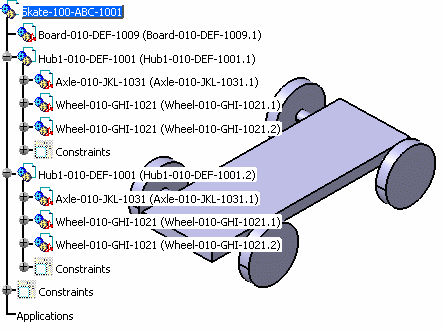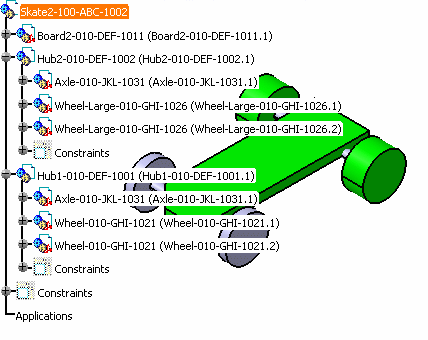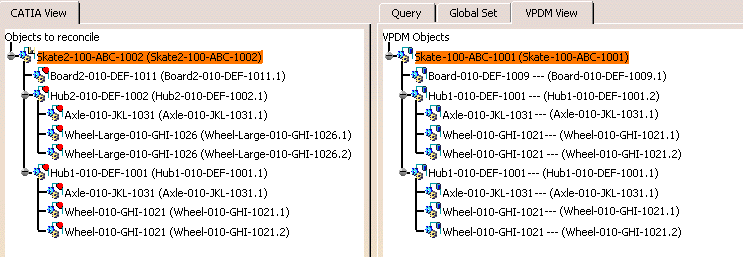- Note that the Apply button is only available if a reconciliation rule has been applied to all objects.
- Executing the Apply function only modifies the content of the CATIA session (not the VPDM). To save your date to ENOVIA V5 VPM or VPMV4, please refer to Saving Documents in the VPDM.
- When reconciling data in ENOVIA V5 VPM, the Apply function
will automatically attempt to obtain locks for all necessary objects
(instances, references, documents) based on the reconciliation rules you
have defined.
- You should not unlock these objects in ENOVIA V5 VPM until you save your modifications.
- If any of the necessary locks cannot be obtained, the Apply function will return an error message detailing the issues (for example, another user may have an object locked). In this case, you should resolve all lock issues and click the Apply button again. Note that if the Apply does not succeed due to lock failures, all objects whose locks were obtained by the reconciliator will be released.
- activated the cache system (Tools->Options->Infrastructure->Product Structure->Cache Management->check option Work with the cache system)
- have invoked the reconciliation option (View->Toolbars->Reconcile)
- have activated the ENOVIA V5 toolbar (View -> Toolbars->ENOVIAV5)
- have connected to the ENOVIA V5 VPM database (click the Connect User to ENOVIA V5 icon)
To perform this scenario, you will need the following documents:
 The Skate-100-ABC-1001.CATProduct document and its sub-products must have been saved in the VPDM in mode Structure Exposed before you begin the reconciliation process. In the scenario described below, it corresponds to the skate board that the manufacturer sends to his supplier for modification. It is made up of: |
 The documents listed below are those that will be reconciled using the Workpackage Exchange application. |
-
Open the Skate2-100-ABC-1002.CATProduct file.
-
Click the Launch Reconciliation icon
 .
.
The Reconcile window is displayed. -
Click the root object (Skate-100-ABC-1002) in the Objects to reconcile tree, select the Query by object ID query in the Query Criteria scrolling list and click Query.
-
Enter Skate* in the Search String field and click OK.
Skate-100-ABC-1001 is the unique result of the query. -
Click the VPDM View tab.
The mapping has been established between Skate2-100-ABC-1002 and Skate-100-ABC-1001.
The Overwrite mode has been automatically applied to Skate2-100-ABC-1002 in the CATIA View.
-
The following items were re-designed by the supplier, and you want to save them. For each item, select it in the CATIA view and click the New object in VPDM icon
 .
.
- Board2-010-DEF-1011: This is a new object and the manufacturer wants to keep the old board in the VPDM.
- Hub2-010-DEF-1002: This object is new and does not exist in the VPDM.
- Wheel-Large-010-GHI-1026: This object is new and does not exist in the VPDM.
-
For each of the following items, select the item in the CATIA View and click the Overwrite in VPDM icon
 .
.- Skate2-100-ABC-1002: Overwrites the skate stored in the VPDM.
- Hub1-010-DEF-1001: Overwrites the board stored in the VPDM.
-
For each of the following items, map the item using the Query and click the Reload from VPDM icon
 .
.- Axle-010-JKL-1031: The manufacturer wants to keep the original axle.
- Wheel-010-GHI-1021: The manufacturer wants to keep the original wheel.
-
At the bottom right-hand corner, click the Apply button to apply the simulation. A message is given, indicating that the apply has completed successfully. Note that nothing has been modified yet in the VPDM repository, only the content of the CATIA session has been modified.
![]()